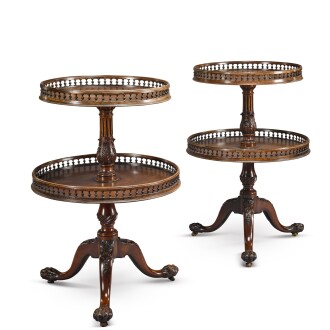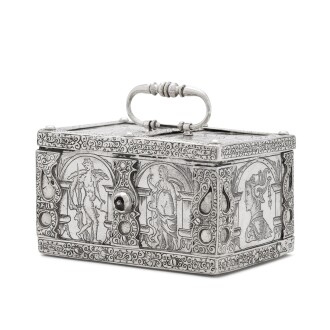T his spring, Sotheby's Furniture, Silver, Clocks & Ceramics auction will offer a carefully curated selection of the very best of English and European craftsmanship. The sale boasts a wonderful group of English silver from one of the world’s finest private collections and which includes several pieces with royal or noble provenance. Charting the evolution of design from Elizabeth I to Elizabeth II, luminaries such as Lewis Pantin, Peter Podio and Paul Storr are among the silversmiths represented.
The sale also features a broad range of clocks by some of the leading makers from the golden age of British horology, spanning the late 17th century through to the mid-19th century. Of particular note amongst the longcase clocks are a month-going example in a fine walnut case by Daniel Quare, an ebonised clock by John Miller, a month-going marquetry clock by Isaac Lowndes, a mahogany clock with Ludlam-type pendulum by John Holmes and a mahogany clock by Charles Haley & Son. There is a very fine marble, porcelain and ormolu timepiece by Benjamin Vulliamy and table clocks by Robert Henderson, Thomas Weeks and William Hughes amongst others.
A group of early 16th century Flemish seigneurial and biblical tapestries are some of the continental highlights whose intricate figural scenes and vivid colours provide a reminder of why these fragments have been so highly prized throughout the ages. The sale also offers fine English and French furniture from the 18th and 19th centuries with an array pieces finished in exquisite materials such as ‘Boulle’ marquetry, oriental lacquer, giltwood & gilt-bronze, and of course employing a plethora of native and exotic timbers. The range of ceramics and glass is no less broad, with rare 18th century Chelsea and Bow figural groups offered alongside a Martin Brothers stoneware 'Wally Bird' tobacco jar.
Online bidding opens on 6 May before closing on May 17. The sale can be viewed at a dedicated exhibition in our New Bond Street galleries from 13 to 17 May.
Auction Highlights

Silver from An Important English Private Collection
Sotheby’s is proud to host one of the world’s finest private collections of English silver which is coming up for sale in its May Furniture, Silver, Clocks and Ceramics Sale and July Treasures Sale. The group of twenty pieces in the May Sale spans over 400 years of silver craftsmanship in England with the focus very much on quality, featuring such preeminent silversmiths as Lewis Pantin and Paul Storr.
The earliest piece in the collection is an Elizabethan beaker (lot 7), hallmarked for London 1588. The sides are engraved with the strapwork ornament which was so popular from the second half of the 16th century onwards both in Britain and throughout Northern Europe. They can often be seen in still life paintings from the Low Countries, such as the one painted by Pieter Claesz in 1642. The objects, food and surroundings in this painting are noticeably more modest than others in the same genre which often depict luxurious scenes with huge silver vessels spilling over with exotic fruits. We can deduce from the simplicity of the Claesz painting that these beakers, while certainly still prized possessions, were intended for informal, and perhaps everyday use.
Right: Pieter Claesz, Still-life with a silver beaker, 1642, sold at Sotheby’s, London, 6 December 2017, lot 41.
As the collection progresses into the late 17th century we come to lot 11, a grand silver cup and cover, and what a contrast it presents to the Elizabethan beaker. Rather than practicality and modesty in scale, the very purpose of this cup is to impress, and functionality is dispensed with altogether. The noble, stocky proportions are lent further strength by the proud lions couchants acting as both finial and feet. The lions themselves are enhanced by cut-card decoration which was beginning to gain popularity at this time.
No collection of silver would be complete without an example of Rococo work, and while English pieces in this style tend to be more conservative than those found in France, Germany and Italy, the Huguenot silversmiths working in England in the early 18th century did produce works of extraordinary invention and vivacity. The Lewis Pantin sauceboats (lot 28) can certainly be included in such a group, and with the dolphin handles and lobsters included in the applied swags it’s easy to imagine these being used to serve some sort of delicious sauce over an elaborate fish dish. Indeed, the 18th century recipe book The Cook Book of Unknown Ladies makes reference to a sauce made using the body and ‘pea’ (egg sacks) of lobster:
‘Get some strong greavy, anchoves, shillot, nutmeg, & all spice. Set ym on ye fire together. Let ym stew a good while. Then strain it & draw a good deal of fresh butter, very thick, a glass of claret or white wine, ye body & pea of a lobster, or body of a crab. Mix all together.’
One of the more unusual pieces in the collection are the Regency ice dishes (lot 32), hallmarked for London 1812 and with the mark of Paul Storr. They are superbly engraved with the arms of Hugh Percy, 3rd Duke of Northumberland (1795-1847) in whose archives exist notes relating to the Duke’s account with Rundell, Bridge and Rundell, the foremost silver retailers of the period, where it explains that the were made to fit on top of a pair of wine coolers. What they were designed to hold is difficult to say for certain, but a likely candidate is ice cream which was an extravagant luxury during the Regency period, and would have been possible to make using the Duke’s ice house at Syon. This delicacy was enjoyed by the crème de la crème of society: on 18th January 1817 the Prince Regent hosted a banquet for the Grand Duke Nicolas of Russia at which his chef Antonin Carême created 121 dishes which were spread over nine courses; one of the many desserts was rose ice cream.

Weaving a Story
For centuries, tapestries were associated with prestige, power and wealth. To this day, they are admired for their visual richness, carried through the complex patterns of clothing, their symbolic and allegorical aspects, as well as for their ability to narrate a story and bring it to life.

- Tournai
It is likely that the present weaving was produced in Tournai, one of the leading centres of high quality tapestries during the second half of the 16th century. Henry VIII, Cardinal Wolsey and the continental courts of Philip the Good, Margaret of Austria, and Francis I were amongst the royals and courtiers of Europe that obtained sets of tapestries from Tournai at this time, often of allegorical significance and therefore of classical and usually biblical subjects.
- Visual richness
The visual richness of the present tapestry is achieved through the complex patterns of fabrics displayed, the individualized outlines of the faces and overall through the arrangement of the figures, somewhat self-contained and in tiers close to the picture plane, and filling an actual space creating an illusion of depth and perspective.
- The Story of Judith and Holofernes
The subject depicted in the present example derives from the Story of Judith and Holofernes and is associated with the triumph of good over evil with Judith as the heroine of the Israelites. With her beauty and wisdom Judith accessed the enemy camp and attracted the eye of the Assyrian leader Holofernes as seen in the present tapestry. After a banquet in her honour, Holofernes left alone with her, became the victim of Judith's mission to disable the Assyrian army and was decapitated. Judith's maid carried the head in a sack into the city of Bethulia and the Assyrians soon fled when they were aware of the death of their commander (Old Testament Apocrypha, 10:5). Judith first appeared as a symbol of virtue overcoming vice in the Middle Ages, then as an allegory of man's misfortune in the hands of a scheming woman in the Renaissance, and in the Counter-Reformation as the symbol of Victory over sin.
An Old Testament Tapestry, Southern Netherlands, probably Tournai, circa 1515, from the Story of Judith and Holofernes, £50,000-80,000.




































